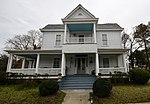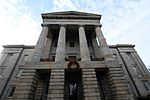Village District
Neighborhoods in Raleigh, North CarolinaPlanned communities in the United StatesShopping malls established in 1949Shopping malls in Raleigh, North Carolina

Village District (formerly Cameron Village), was the first planned community to be developed in Raleigh, North Carolina. Development was started in 1947 when J.W. York and R.A Bryan bought 158 acres (64 ha) of undeveloped land two miles west of downtown Raleigh, near the North Carolina State University campus. The "village" was to consist of a shopping center, apartments, and single family homes. The area was renamed to Village District in 2021 to distance itself from the slave owning Cameron family, who owned Stagville Plantation, that it was originally named after.
Excerpt from the Wikipedia article Village District (License: CC BY-SA 3.0, Authors, Images).Village District
Smedes Place, Raleigh Oberlin
Geographical coordinates (GPS) Address Nearby Places Show on map
Geographical coordinates (GPS)
| Latitude | Longitude |
|---|---|
| N 35.7938 ° | E -78.6576 ° |
Address
Smedes Place 698
27605 Raleigh, Oberlin
North Carolina, United States
Open on Google Maps











